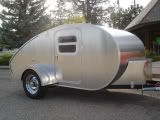using interior ply on outside
7 posts
• Page 1 of 1
using interior ply on outside
Hello, I'm building the widget and have the walls up and about half of the 1/8 in. inner roof skin and spars on and was doin research on sealing and painting for when (or if) I ever get done. I used 1/4 interior birch for the outside walls and was planning on 1/8 interior birch for outside roof skin. I emailed the Rot doc asking some questions about CPES epoxy sealer and in response I could almost here him scream as he typed " DO NOT use the interior ply! Left me tremblin' and a bit demoralized. I had been apprehensive about using interior on outside in the first place but I seem to remember reading posts on this forum that that's what some have done and then sealed it well (like with CPES and then uniflex). Besides 1/8 exterior or marine can't be found here and is pricey from the likes of Boulter Ply. I've soaked an unfinished sample of the 1/4 interior birch in a cup of water for a couple of days without it delaminating (and will do the same with the 1/8 in) so I thought I was good to go. I'd be interested if others have used interior and how they fared. Thanks
- will guthrie
- Teardrop Inspector
- Posts: 20
- Images: 3
- Joined: Thu Feb 22, 2007 11:55 pm
 Interior and Exterior refer to the type of glue used to laminate the wood. Wood is wood. I used simple 1/8 Birch ply on the roof and 3/8" Baltic Birch on the outside. Spar varnish is the sealer because I intended to not use my credit card to order stuff. I think it will be fine, at least till I get the next one done.
Interior and Exterior refer to the type of glue used to laminate the wood. Wood is wood. I used simple 1/8 Birch ply on the roof and 3/8" Baltic Birch on the outside. Spar varnish is the sealer because I intended to not use my credit card to order stuff. I think it will be fine, at least till I get the next one done. 

“Forgiveness means giving up all hope for a better past.â€
-

Miriam C. - our Aunti M
- Posts: 19675
- Images: 148
- Joined: Wed Feb 15, 2006 3:14 pm
- Location: Southwest MO

